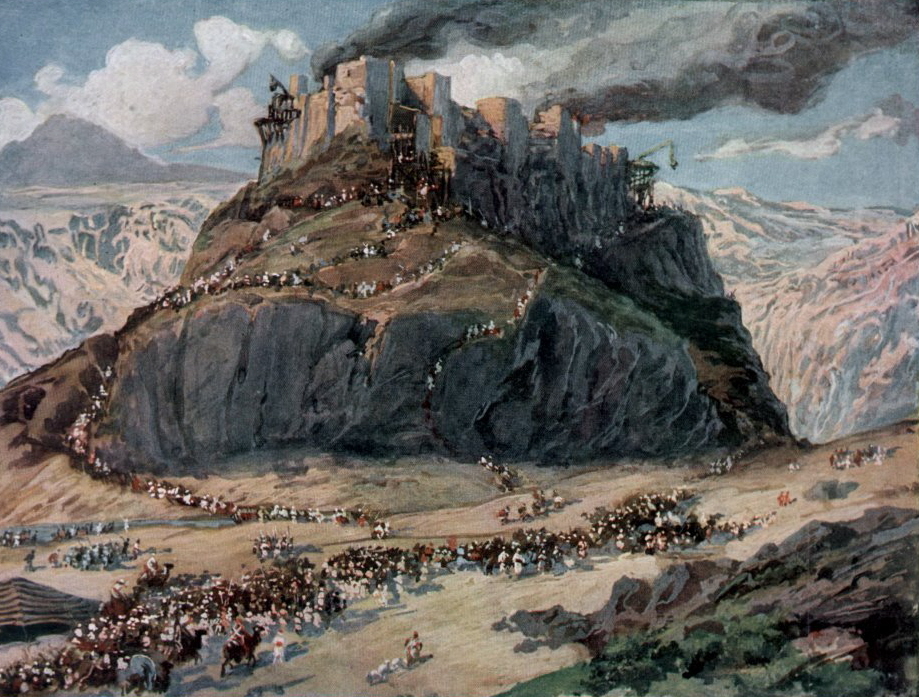|
Ar (city)
Ar is mentioned in the Hebrew Bible several times as a city of ancient Moab (). While the exact location is unknown, it is likely to have been in the southern part of the Arnon (western Jordan), Arnon Valley, which is the present day Wadi Mujib gorge in Jordan. The city was one of Moab's most prominent, being listed by the prophet Isaiah in his denunciation of the Moabite nation (). Matthew Poole suggested that "the city was seated in an island in the middle of the river". The Bible speaks of Ar as being captured by the Amorite Sihon, King Sihon (). Modern scholars believe that the word "Ar" likely meant "city". See also *Isaiah 15, prophecy against Ar and Moab References {{Reflist Hebrew Bible cities Book of Isaiah ... [...More Info...] [...Related Items...] OR: [Wikipedia] [Google] [Baidu] |
Hebrew Bible
The Hebrew Bible or Tanakh (;"Tanach" ''Random House Webster's Unabridged Dictionary''. Hebrew: ''Tānāḵh''), also known in Hebrew as Miqra (; Hebrew: ''Mīqrā''), is the Biblical canon, canonical collection of Hebrew language, Hebrew scriptures, including the Torah, the Nevi'im, and the Ketuvim. Different branches of Judaism and Samaritanism have maintained different versions of the canon, including the 3rd-century Septuagint text used by Second-Temple Judaism, the Syriac language Peshitta, the Samaritan Torah, the Dead Sea Scrolls, and most recently the 10th century medieval Masoretic Text, Masoretic text created by the Masoretes currently used in modern Rabbinic Judaism. The terms "Hebrew Bible" or "Hebrew Canon" are frequently confused with the Masoretic text, however, this is a medieval version and one of several ... [...More Info...] [...Related Items...] OR: [Wikipedia] [Google] [Baidu] |
Moab
Moab ''Mōáb''; Assyrian: 𒈬𒀪𒁀𒀀𒀀 ''Mu'abâ'', 𒈠𒀪𒁀𒀀𒀀 ''Ma'bâ'', 𒈠𒀪𒀊 ''Ma'ab''; Egyptian: 𓈗𓇋𓃀𓅱𓈉 ''Mū'ībū'', name=, group= () is the name of an ancient Levantine kingdom whose territory is today located in the modern state of Jordan. The land is mountainous and lies alongside much of the eastern shore of the Dead Sea. The existence of the Kingdom of Moab is attested to by numerous archaeological findings, most notably the Mesha Stele, which describes the Moabite victory over an unnamed son of King Omri of Israel, an episode also noted in 2 Kings . The Moabite capital was Dibon. According to the Hebrew Bible, Moab was often in conflict with its Israelite neighbours to the west. Etymology The etymology of the word Moab is uncertain. The earliest gloss is found in the Koine Greek Septuagint () which explains the name, in obvious allusion to the account of Moab's parentage, as ἐκ τοῦ πατρός μου ("from my ... [...More Info...] [...Related Items...] OR: [Wikipedia] [Google] [Baidu] |
Arnon (western Jordan)
Wadi Mujib ( ar, وادي الموجب, ''Wadi el-Mujib''), also known as Arnon Stream (Hebrew language, Hebrew: נַחַל ארנון), is a river in Jordan. The river empties into the Dead Sea circa below sea level. Today, Wadi Mujib is fed by seven tributaries. The western part of the river is the site of the Mujib Biosphere Reserve, popular for hikes & canyoning amid dramatic rock formations. Geography During the Last Glacial Period, last ice age the water level of the Dead Sea reached below sea level, about higher than it is today. It flooded the lower areas of the canyons along its banks, which became bays and begun to accumulate sediments. As the climatic conditions changed, about 20,000 years ago, the water level of the lake dropped, leaving the re-emergent canyons blocked with lake marl. Most canyons managed to cut through their plugged outlets and to resume their lower courses. However, Wadi Mujib, abandoned its former outlet by breaking through a cleft in the san ... [...More Info...] [...Related Items...] OR: [Wikipedia] [Google] [Baidu] |
Isaiah
Isaiah ( or ; he, , ''Yəšaʿyāhū'', "God is Salvation"), also known as Isaias, was the 8th-century BC Israelite prophet after whom the Book of Isaiah is named. Within the text of the Book of Isaiah, Isaiah himself is referred to as "the prophet", but the exact relationship between the Book of Isaiah and the actual prophet Isaiah is complicated. The traditional view is that all 66 chapters of the book of Isaiah were written by one man, Isaiah, possibly in two periods between 740 BC and c. 686 BC, separated by approximately 15 years, and that the book includes dramatic prophetic declarations of Cyrus the Great in the Bible, acting to restore the nation of Israel from Babylonian captivity. Another widely held view is that parts of the first half of the book (chapters 1–39) originated with the historical prophet, interspersed with prose commentaries written in the time of King Josiah a hundred years later, and that the remainder of the book dates from immediately before an ... [...More Info...] [...Related Items...] OR: [Wikipedia] [Google] [Baidu] |
Matthew Poole
Matthew Poole (1624–1679) was an English Non-conformist theologian and biblical commentator. Life to 1662 He was born at York, the son of Francis Pole, but he spelled his name Poole, and in Latin Polus; his mother was a daughter of Alderman Toppins there. He was educated at Emmanuel College, Cambridge, from 1645, under John Worthington. Having graduated B.A. at the beginning of 1649, he succeeded Anthony Tuckney, in the sequestered rectory of St Michael le Querne, then in the fifth classis of the London province, under the parliamentary system of presbyterianism. This was his only preferment. He proceeded M.A. in 1652. On 14 July 1657 he was one of eleven Cambridge graduates incorporated M.A. at Oxford on occasion of the visit of Richard Cromwell as chancellor. Poole was a ''jure divino'' presbyterian, and an authorised defender of the views on ordination of the London provincial assembly, as formulated by William Blackmore. After the Restoration of the English monarchy, i ... [...More Info...] [...Related Items...] OR: [Wikipedia] [Google] [Baidu] |
Bible
The Bible (from Koine Greek , , 'the books') is a collection of religious texts or scriptures that are held to be sacred in Christianity, Judaism, Samaritanism, and many other religions. The Bible is an anthologya compilation of texts of a variety of forms originally written in Hebrew, Aramaic, and Koine Greek. These texts include instructions, stories, poetry, and prophecies, among other genres. The collection of materials that are accepted as part of the Bible by a particular religious tradition or community is called a biblical canon. Believers in the Bible generally consider it to be a product of divine inspiration, but the way they understand what that means and interpret the text can vary. The religious texts were compiled by different religious communities into various official collections. The earliest contained the first five books of the Bible. It is called the Torah in Hebrew and the Pentateuch (meaning ''five books'') in Greek; the second oldest part was a coll ... [...More Info...] [...Related Items...] OR: [Wikipedia] [Google] [Baidu] |
Amorite
The Amorites (; sux, 𒈥𒌅, MAR.TU; Akkadian: 𒀀𒈬𒊒𒌝 or 𒋾𒀉𒉡𒌝/𒊎 ; he, אֱמוֹרִי, 'Ĕmōrī; grc, Ἀμορραῖοι) were an ancient Northwest Semitic-speaking people from the Levant who also occupied large parts of southern Mesopotamia from the 21st century BC to the end of the 17th century BC, where they established several prominent city-states in existing locations, such as Isin, Larsa and later notably Babylon, which was raised from a small town to an independent state and a major city. The term in Akkadian and Sumerian texts refers to the Amorites, their principal deity and an Amorite kingdom. The Amorites are also mentioned in the Bible as inhabitants of Canaan both before and after the conquest of the land under Joshua. Origin In the earliest Sumerian sources concerning the Amorites, beginning about 2400 BC, the land of the Amorites ("the ''Mar.tu'' land") is associated not with Mesopotamia but with the lands to the west o ... [...More Info...] [...Related Items...] OR: [Wikipedia] [Google] [Baidu] |
Sihon
Sihon was an Amorite king mentioned in the Hebrew Bible, who refused to let the Israelites pass through his country. Biblical accounts The Book of Numbers recounts that as the Israelites making their Exodus journey came to the country east of the Jordan, near Heshbon, King Siḥon of the Amorites refused to let them pass through his land: :"But Sihon would not allow Israel to pass through his territory. So Sihon gathered all his people together and went out against Israel in the wilderness, and he came to Jahaz and fought against Israel. Then Israel defeated him with the edge of the sword, and took possession of his land from the Arnon to the Jabbok, as far as the people of Ammon ..." () Moses allocated the land of Sihon, the king of Heshbon, to the Tribe of Gad in the allocation of land to the Israelite tribes (). In a similar way, the Israelites took the country of Og, and these two victories gave them possession of continuous land east of the Jordan, from the Arnon to t ... [...More Info...] [...Related Items...] OR: [Wikipedia] [Google] [Baidu] |
Isaiah 15
Isaiah 15 is the fifteenth chapter of the Book of Isaiah in the Hebrew Bible or the Old Testament of the Christian Bible. This book contains the prophecies attributed to the prophet Isaiah, and is one of the Books of the Prophets. This chapter and the following chapter deal with the forthcoming history of Moab. Text The original text was written in Hebrew language. This chapter is divided into 9 verses. Textual witnesses Some early manuscripts containing the text of this chapter in Hebrew are of the Masoretic Text tradition, which includes the Codex Cairensis (895), the Petersburg Codex of the Prophets (916), Aleppo Codex (10th century), Codex Leningradensis (1008). Fragments containing parts of this chapter were found among the Dead Sea Scrolls (3rd century BCE or later): * 1QIsaa: complete * 1QIsab: extant verses 2-9 * 4QIsao (4Q68): extant verse 1 Extant ancient manuscripts of a translation into Koine Greek known as the Septuagint, made in the last few centuries BCE, ... [...More Info...] [...Related Items...] OR: [Wikipedia] [Google] [Baidu] |
Hebrew Bible Cities
Hebrew (; ; ) is a Northwest Semitic language of the Afroasiatic language family. Historically, it is one of the spoken languages of the Israelites and their longest-surviving descendants, the Jews and Samaritans. It was largely preserved throughout history as the main liturgical language of Judaism (since the Second Temple period) and Samaritanism. Hebrew is the only Canaanite language still spoken today, and serves as the only truly successful example of a dead language that has been revived. It is also one of only two Northwest Semitic languages still in use, with the other being Aramaic. The earliest examples of written Paleo-Hebrew date back to the 10th century BCE. Nearly all of the Hebrew Bible is written in Biblical Hebrew, with much of its present form in the dialect that scholars believe flourished around the 6th century BCE, during the time of the Babylonian captivity. For this reason, Hebrew has been referred to by Jews as '' Lashon Hakodesh'' (, ) since ancie ... [...More Info...] [...Related Items...] OR: [Wikipedia] [Google] [Baidu] |



.jpg)


